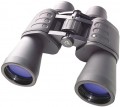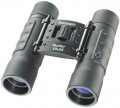Field of view 1 km away
The diameter of the area visible through binoculars / monoculars from a distance of 1 km — in other words, the largest distance between two points at which they can be seen simultaneously from this distance. It is also called "linear field of view". Along with the angular field of view (see below), this parameter characterizes the space covered by the optics; at the same time, it describes the capabilities of a particular model more clearly than data on viewing angles. Models with magnification adjustment (see above) usually indicate the maximum field of view — at the lowest magnification and
the widest angle of view. This information is often supplemented by data on the minimum value.
Min. focus distance
The smallest distance to the observed object, at which it will be clearly visible through binoculars / monoculars. All such optical instruments were initially created for observing remote objects, therefore, not all of them are able to work at short distances. When choosing a model for this parameter, one should proceed from the expected observation conditions: ideally, the minimum focus distance should not be greater than the smallest possible distance to the observed object.
Twilight factor
A complex indicator that describes the quality of binoculars / monoculars at dusk — when the illumination is weaker than during the day, but not yet as dim as in the deep evening or at night. It is primarily about the ability to see small details through the device. The need to use this parameter is due to the fact that twilight is a special condition. In daylight, the visibility of small details through binoculars is determined primarily by the magnification of the optics, and in night light, by the diameter of the lens (see below); at dusk, both of these indicators affect the quality. This feature takes into account the twilight factor. Its specific value is calculated as the square root of the product of the multiplicity and the diameter of the lens. For example, for 8x40 binoculars, the twilight factor will be the root of 8x40=320, that is, approximately 17.8. In models with power adjustment (see above), the minimum twilight factor is usually indicated at the lowest magnification, but data is often given for the maximum. The lowest value of this parameter for normal visibility at dusk is considered to be 17. At the same time, it is worth noting that the twilight factor does not take into account the actual light transmission of the system — and it strongly depends on the quality of lenses and prisms, the use of antireflection coatings, etc. Therefore, the actual image quality at dusk for two models with the same twilight factor may differ markedly.
Relative brightness
One of the parameters describing the quality of visibility through an optical device in low light conditions. Relative brightness is denoted as the diameter of the exit pupil (see below) squared; the higher this number, the more light the binoculars/monoculars let through. At the same time, this indicator does not take into account the quality of lenses, prisms and coatings used in the design. Therefore, comparing the two models in terms of relative brightness is only possible approximately, since even if the values are equal, the actual image quality may differ markedly.
Lens diameter
The lens diameter is the front lens of the binocular/monocular. This parameter is also called "aperture". Designate it in millimetres. Aperture is one of the most important characteristics of an optical device: it describes the amount of light that the device is able to "capture" into the lens, and largely determines the image quality in low light. Therefore, the second number in the traditional marking of binoculars / monoculars is precisely the diameter of the lens — for example, 8x40 mm corresponds to 8x binoculars with an aperture of 40 mm. In addition, with a large lens it is easier to provide a wide field of view without sacrificing magnification. In general, the larger the aperture, the more advanced the optical device is considered. On the other hand, the increase in lenses has a corresponding effect on the weight and dimensions of the entire structure. And you should not forget about the influence of individual components of the system (for example, prisms) on the overall image quality.
Exit pupil diameter
The diameter of the exit pupil created by the optical system of a binocular/monocular. The exit pupil is called the projection of the front lens of the lens, built by the optics in the region of the eyepiece; this image can be observed in the form of a characteristic light circle, if you look into the eyepiece not close, but from a distance of 30 – 40 cm. The diameter of this circle is measured according to a special formula — dividing the diameter of the lens by the multiplicity (see above). For example, an 8x40 model would have a pupil diameter of 40/8=5mm. This indicator determines the overall aperture of the device and, accordingly, the image quality in low light: the larger the pupil diameter, the brighter the “picture” will be (of course, with the same quality of prisms and glasses, because they also affect the brightness). In addition, it is believed that the diameter of the exit pupil should be no less than that of the pupil of the human eye — and the size of the latter can vary. So, in daylight, the pupil in the eye has a size of 2-3 mm, and in the dark — 7-8 mm in adolescents and adults, and about 5 mm in the elderly. This point should be taken into account when choosing a model for specific conditions: after all, fast models are expensive, and it hardly makes sense to overpay for a large pupil if you need binoculars exclusively for daytime use.
Anti reflective coating
Coating is a special coating applied to the surface of the lens. This coating is intended to reduce light loss at the air-glass interface. Such losses inevitably arise due to the reflection of light, and the antireflective coating “turns” the reflected rays back, thus increasing the light transmission of the lens. In addition, this function reduces the amount of glare on objects visible through binoculars/monoculars. There are
single-layer,
full single-layer,
multi-layer,
full multi-layer. More details about them:
- Single layer. This marking indicates that one or more lens surfaces (but not all) have a single layer of anti-reflective coating applied to them. This is inexpensive and can be used even in entry-level optical instruments. On the other hand, it filters out a certain spectrum of light, which distorts the color rendition in the visible image - sometimes quite noticeably. In addition, in this case, on some lens surfaces there is no coating at all, which inevitably leads to glare in the field of view. Thus, single-layer coating is the simplest type and is used extremely rarely, mainly in budget models.
- Full single layer. A variation of the single-layer coating described above, in which an anti-reflective coating is present on all surfaces of the lenses (at each air-glass interface). Although this option is al
...so characterized by color distortion, it is devoid of another, the most key drawback of “incomplete” enlightenment - glare in the field of view. And the mentioned color distortion is most often not critical. With all this, full single-layer coating is relatively inexpensive, which is why it is very popular in entry-level and entry-mid-level models.
- Multi-layered. A type of coating in which multiple layers of reflective coating are applied to one or more lens surfaces (but not all). The advantage of such a coating over a single-layer coating is that it uniformly transmits almost the entire visible spectrum and does not create noticeable color distortions. The absence of a coating on individual surfaces reduces the cost of the device (compared to full multi-layer coating), but it is impossible to completely get rid of glare in such a system.
- Fully multi-layered. The most advanced and effective of modern types of coating: a multilayer coating is applied to all surfaces of the lenses. This way, high brightness and clarity of the “picture” is achieved, with natural color rendition and no glare. The classic disadvantage of this option is its high cost; Accordingly, full multi-layer coating is typical mainly for high-end models.Prism
A type of prism used in binocular/monocular construction. A prism is one of the key elements of an optical system: it is a glass polyhedron through which light passes on its way from the lens to the eyepiece. The need to use such polyhedra is associated with the peculiarities of the creation of optical devices of high multiplicity. In other models, there are two main options:
—
Porro. A distinctive feature of binoculars with such prisms is that the optical axes of the eyepieces are offset relative to the lenses — in other words, the distance between the eyepieces differs from the distance between the output lenses. This makes the design somewhat more cumbersome than with Roof prisms; on the other hand, the lenses can be spread over a long distance, which provides a better sense of the volume of the observed picture — especially at long distances. In addition, binoculars with Porro prisms are easier to equip with interpupillary distance adjustment (see below).
—
Roof. In models with prisms of this type, the eyepiece and the objective are on the same optical axis — the binoculars look as if the light in it goes from "input" to "exit" directly, without any prism at all (although in reality this, of course, is not So). Such devices are smaller and lighter than Porro systems, but more complex and more expensive.
Tripod adapter
The presence in the design of the binoculars / monocular
socket for attaching an adapter for a tripod(the adapter itself is not included in the kit, unless otherwise indicated). This feature is especially important for high magnification models (see above): they are usually heavy, making it difficult to hold stable in your hands, and at high magnification, even slight shaking can make observation impossible. In addition, mounting on a tripod is convenient for constant observation of a certain place, and such observation does not always require high magnification. Therefore, even fairly small devices can have the possibility of attaching an adapter. The adapters themselves can be designed for different sizes of tripod mounts — this must be taken into account when choosing such a model.

